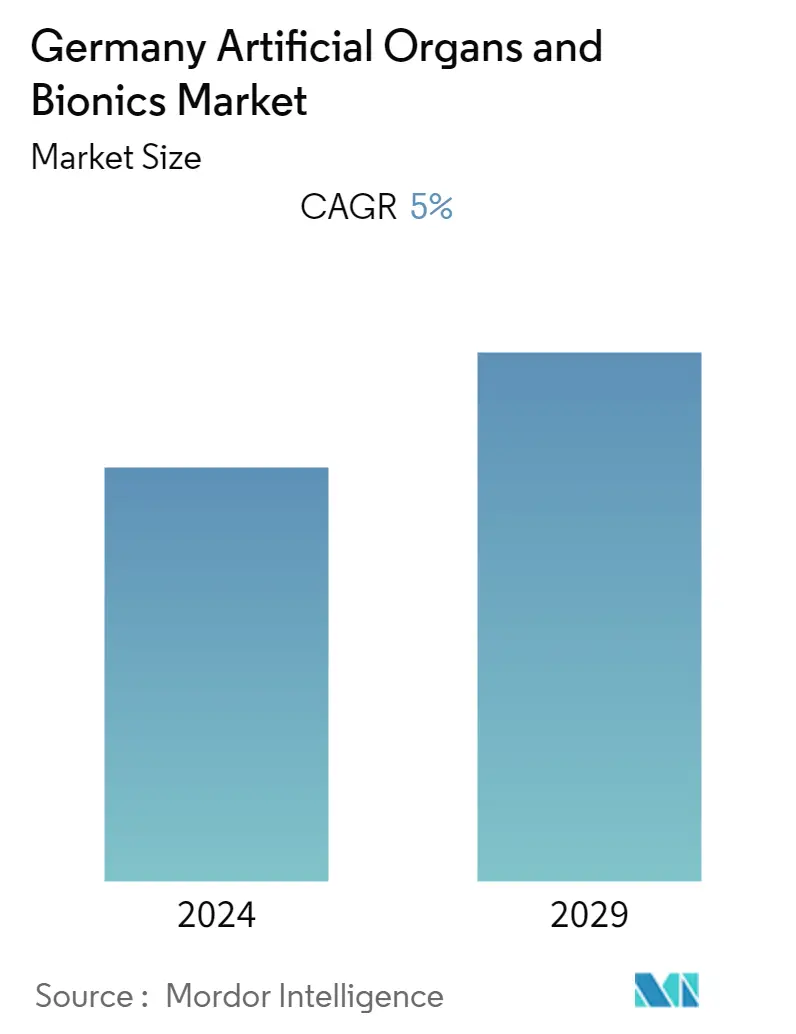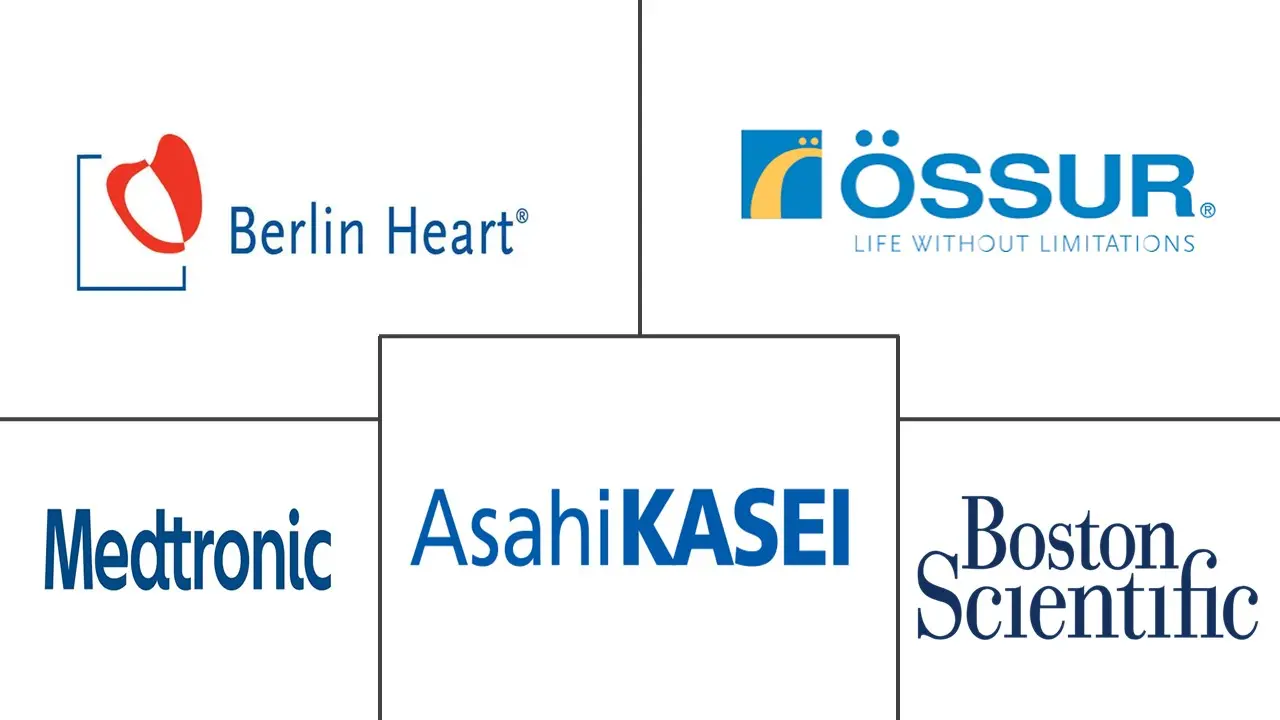Market Size of Germany Artificial Organs and Bionics Industry

| Study Period | 2019 - 2029 |
| Base Year For Estimation | 2023 |
| Forecast Data Period | 2024 - 2029 |
| Historical Data Period | 2019 - 2022 |
| CAGR | 5.00 % |
| Market Concentration | Low |
Major Players
*Disclaimer: Major Players sorted in no particular order |
Germany Artificial Organs & Bionic Implants Market Analysis
The German artificial organs and bionics market is expected to register a CAGR of 5% during the forecast period.
The COVID-19 pandemic had an unprecedented public health threat that harmed communities, industries, enterprises, and people throughout Germany. COVID-19 hampered the supply and manufacture of artificial organs and bionics. According to the study published by Colégio Brasileiro de Cirurgiões in May 2021, in Germany, there were no appreciable changes in the number of patients on the lung transplant waiting list, the overall number of organ donors, or the death rate on the lung transplant waiting list in the first five months of 2020. Moreover, a study published in Transplantation in July 2022 revealed a slight decline in transplant rates in Germany along with higher death rates. As a result, there were no changes in the organ transplant waiting list. However, there was a slight decline in transplant activity in the country hampered the growth of the studied market. The market recovery over the last two years has been driven by the high prevalence of diseases and product launches by market players.
The major factors responsible for the growth of the artificial organs and bionics market include the scarcity of donor organs for organ transplantation and technological advancements. The lack of availability of potential organs to transplant has been a major issue. As reported by the IRODaT in July 2022, Germany's organ donation rate remained stubbornly low in 2020. More than 9,000 people are already on the organ waiting list. Germany's organ donation rate is over three times lower than the United States and more than four times lower than that of world leader Spain, with 11.5 donors per million people. Bionics and artificial organs can cater to the needs of those in need of organ transplantations and replacements. They can replicate the function of damaged organs.
Moreover, various organic and inorganic strategies adopted by key market players are expected to boost market growth during the forecast period. For instance, in July 2021, Ottobock planned to prepare for a huge stock market IPO in 2022 that may value the German manufacturer of prosthetic limbs at more than EUR 5 billion (USD 5.9 billion). Additionally, in November 2021, Ottobock acquired 100% of the shares of suitX, a US-based company spun out of the Robotics and Human Engineering Lab at the University of California, Berkeley, which specializes in the research and development of occupational and medical exoskeletons. Ottobock and suitX are combining their expertise and products to take the exoskeleton market to a new level and to foster the worldwide adoption of exoskeletons.
However, other factors, such as the high cost of the procedure, the risk of compatibility issues, and malfunctions are expected to impede the market growth.
Germany Artificial Organs & Bionic Implants Industry Segmentation
Artificial organs are mechanical devices that can temporarily or permanently substitute for a body organ. Artificial organs are made by humans and implemented in human bodies using living tissue. Bionics refers to the replacement or improvement of body parts by mechanical devices.
The German artificial organs and bionics market is segmented by product type (artificial organs such as artificial hearts, artificial kidneys, cochlear implants, and other organ types) and bionics (ear bionics, orthopedic bionics, cardiac bionics, and other bionics). The report offers the value (in USD million) for the above segments.
| By Type | ||||||
| ||||||
|
Germany Artificial Organs and Bionics Market Size Summary
The German artificial organs and bionics market is poised for growth, driven by technological advancements and the increasing scarcity of donor organs for transplantation. The market has shown resilience in the aftermath of the COVID-19 pandemic, which initially disrupted supply chains and manufacturing processes. Despite these challenges, the market has rebounded due to the high prevalence of diseases and innovative product launches. Key players in the industry are leveraging both organic and inorganic strategies to enhance their market presence, with significant investments and acquisitions aimed at advancing bionic and prosthetic technologies. The demand for artificial organs, such as artificial kidneys and cochlear implants, is expected to rise, fueled by the growing incidence of chronic diseases and hearing impairments among the aging population.
The market landscape is moderately competitive, with major global players dominating the scene. Companies like Abiomed Inc., Asahi Kasei Medical Co. Ltd, and Boston Scientific Corporation are at the forefront, benefiting from substantial research funding and robust distribution networks. The artificial kidney segment is anticipated to expand due to the increasing prevalence of kidney diseases and the rising demand for kidney transplants. Similarly, the cochlear implant segment is expected to grow, driven by the rising number of individuals with hearing loss and advancements in implant technology. Overall, the German artificial organs and bionics market is set to experience steady growth, supported by ongoing innovations and a growing need for organ replacements and enhancements.
Germany Artificial Organs and Bionics Market Size - Table of Contents
-
1. MARKET DYNAMICS
-
1.1 Market Overview
-
1.2 Market Drivers
-
1.2.1 Scarcity of Donor Organs for Organ Transplantation
-
1.2.2 Technological Advancements
-
-
1.3 Market Restraints
-
1.3.1 Expensive Procedures
-
1.3.2 Risk of Compatibility Issues and Malfunctions
-
-
1.4 Porter's Five Forces Analysis
-
1.4.1 Threat of New Entrants
-
1.4.2 Bargaining Power of Buyers/Consumers
-
1.4.3 Bargaining Power of Suppliers
-
1.4.4 Threat of Substitute Products
-
1.4.5 Intensity of Competitive Rivalry
-
-
-
2. MARKET SEGMENTATION (Market Size by Value - USD million)
-
2.1 By Type
-
2.1.1 Artificial Organ
-
2.1.1.1 Artificial Heart
-
2.1.1.2 Artificial Kidney
-
2.1.1.3 Cochlear Implants
-
2.1.1.4 Other Organ Types
-
-
2.1.2 Bionics
-
2.1.2.1 Ear Bionics
-
2.1.2.2 Orthopedic Bionic
-
2.1.2.3 Cardiac Bionics
-
2.1.2.4 Other Bionics
-
-
-
Germany Artificial Organs and Bionics Market Size FAQs
What is the current Germany Artificial Organs and Bionics Market size?
The Germany Artificial Organs and Bionics Market is projected to register a CAGR of 5% during the forecast period (2024-2029)
Who are the key players in Germany Artificial Organs and Bionics Market?
Boston Scientific Corporation, Ossur, Medtronic PLC, Berlin Heart GmbH and Asahi Kasei Medical Co., Ltd are the major companies operating in the Germany Artificial Organs and Bionics Market.

